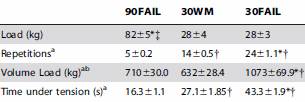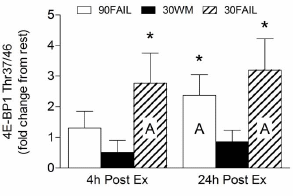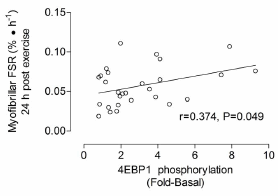Study shows you build up just as much muscle with low weights and lots of reps
After a training session using weights at 30 percent of your 1RM your muscles build up just as much protein as they do after training at 90 percent of your 1RM. At least they do so if you believe the results of a study published by researchers at McMaster University in Canada in the prestigious PLoS One.
There’s a widespread belief among strength athletes that you’ll gain most muscle mass by doing sets with heavy weights. In other words: sets with weights that are at least 60 percent of your 1RM. The researchers wanted to know whether this really is so. After all, the results that researchers have obtained with Kaatsu training – at 30 percent of the 1RM – would seem to indicate otherwise.
So the Canadians got 15 male students, who were used to doing weight training for their legs, to do weight training on 3 occasions. On one occasion the men trained in the conventional way. They did 4 sets of leg-extensions at 90 percent of their 1RM, and were asked to perform as many reps as they could [90FAIL].
[TABLE="width: 170, align: left"]
<tbody>[TR]
[TD="align: center"]<iframe src="http://www.ergo-log.com/archstamina.html" width="170" height="380" scrolling="no" frameborder="0"></iframe>[/TD]
[/TR]
</tbody>[/TABLE]

On a second occasion the men trained with weights at 30 percent of their 1RM, and managed three times as many reps as they had during the 90FAIL session [30WM]. So during the 30WM and the 90FAIL sessions the students put in the same amount of effort.
On a third occasion the students trained again with weights at 30 percent of their 1RM, but performed as many reps as they could [30FAIL].
Just before, and 4 and 24 hours after, the training sessions the researchers took small samples of muscle tissue from the students’ legs. When the researchers measured the total production of muscle protein [Mixed FSR], contracting muscle proteins [Myofibrillary FSR] and non-contracting muscle proteins [Sarcoplasmic FSR], they noticed that both at-failure training sessions had the same amount of muscle-strengthening effect.
[TABLE="align: right"]
<tbody>[TR]
[TD="align: center"]
[/TD]
[/TR]
</tbody>[/TABLE]

Not in all, but in a number of aspects the 30FAIL session was even more effective than the 90FAIL session. The 30FAIL session resulted for example in more activation of the anabolic signal protein 4E-BP1 in the muscle cells. The more active this protein is the higher the production of contracting muscle protein.


"Low-load contractions performed with numerous repetitions or high-load contractions performed for fewer repetitions will result in similar training induced gains in muscle hypertrophy as previously suggested", the researchers write summarising.
Most sports scientists think that strength athletes make most progression by doing short, heavy sets (of 4-6 reps) rather than longer sets of 12-16 reps with lighter weights. If the Canadians’ assertions are correct, then it would be worthwhile for strength athletes to include sets of 20-30 reps in their workouts.
After a training session using weights at 30 percent of your 1RM your muscles build up just as much protein as they do after training at 90 percent of your 1RM. At least they do so if you believe the results of a study published by researchers at McMaster University in Canada in the prestigious PLoS One.
There’s a widespread belief among strength athletes that you’ll gain most muscle mass by doing sets with heavy weights. In other words: sets with weights that are at least 60 percent of your 1RM. The researchers wanted to know whether this really is so. After all, the results that researchers have obtained with Kaatsu training – at 30 percent of the 1RM – would seem to indicate otherwise.
So the Canadians got 15 male students, who were used to doing weight training for their legs, to do weight training on 3 occasions. On one occasion the men trained in the conventional way. They did 4 sets of leg-extensions at 90 percent of their 1RM, and were asked to perform as many reps as they could [90FAIL].
[TABLE="width: 170, align: left"]
<tbody>[TR]
[TD="align: center"]<iframe src="http://www.ergo-log.com/archstamina.html" width="170" height="380" scrolling="no" frameborder="0"></iframe>[/TD]
[/TR]
</tbody>[/TABLE]

On a second occasion the men trained with weights at 30 percent of their 1RM, and managed three times as many reps as they had during the 90FAIL session [30WM]. So during the 30WM and the 90FAIL sessions the students put in the same amount of effort.
On a third occasion the students trained again with weights at 30 percent of their 1RM, but performed as many reps as they could [30FAIL].
Just before, and 4 and 24 hours after, the training sessions the researchers took small samples of muscle tissue from the students’ legs. When the researchers measured the total production of muscle protein [Mixed FSR], contracting muscle proteins [Myofibrillary FSR] and non-contracting muscle proteins [Sarcoplasmic FSR], they noticed that both at-failure training sessions had the same amount of muscle-strengthening effect.
[TABLE="align: right"]
<tbody>[TR]
[TD="align: center"]
[/TD]
[/TR]
</tbody>[/TABLE]

Not in all, but in a number of aspects the 30FAIL session was even more effective than the 90FAIL session. The 30FAIL session resulted for example in more activation of the anabolic signal protein 4E-BP1 in the muscle cells. The more active this protein is the higher the production of contracting muscle protein.


"Low-load contractions performed with numerous repetitions or high-load contractions performed for fewer repetitions will result in similar training induced gains in muscle hypertrophy as previously suggested", the researchers write summarising.
Most sports scientists think that strength athletes make most progression by doing short, heavy sets (of 4-6 reps) rather than longer sets of 12-16 reps with lighter weights. If the Canadians’ assertions are correct, then it would be worthwhile for strength athletes to include sets of 20-30 reps in their workouts.




